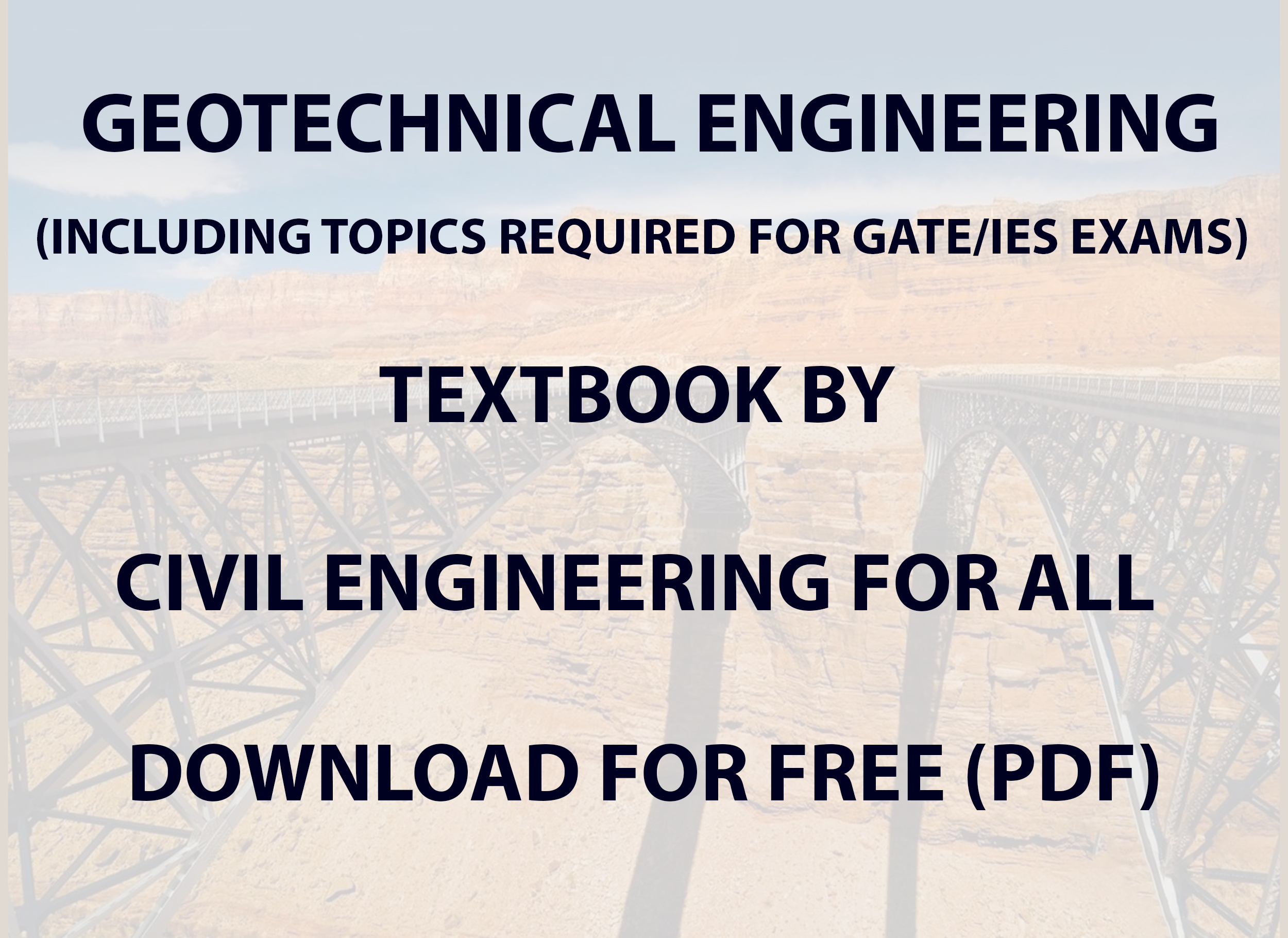

TOPICS COVERED
SOIL MECHANICS
Introduction and Development of Soil Mechanics
Soil Formation
Texture and structure of Soils
Soil Deposits in India
Composition of Soil Terminology and Definitions
Relationships
INDEX PROPERTIES AND CLASSIFICATION TESTS
Soil Color, Particle Shape
Specific Gravity of Soil Solids
Water Content
Density Index
In.-Situ Unit Weight
Particle Size Distribution (Mechanical Analysis)
Consistency of Clay
Activity of Clays
Unconfined Compression Strength and Sensitivity of Clays
Thixotropy of Clays
IDENTIFICATION AND CLASSIFICATION OF SOILS
Introduction
Field Identification of Soils
Soil Classification – The Need
Engineering Soil Classification and desirable features
Classification Systems – More common ones
SOIL MOISTURE PERMEABILITY AND CAPILLARITY
Introduction
Soil Moisture and Modes of Occurrence
Neutral and Effective Pressures
Flow of Water Through Soil-Permeability
Determination of Permeability
Factors Affecting Permeabllity
Values of Permeability
Permeability of Layered Soils
Capillarity
SEEPAGE AND FLOWNETS
Introduction
Flow Net for One-dimensional Flow
Flow Net for Two-Dimensional Flow
Basic Equation for Seepage
Seepage Through Non-Homogeneous and Anisotropic Soil
Top Flow Line in an Earth Dam
Radial Flow Nets
Methods of Obtaining Flow Nets
Quicksand
Seepage Forces
Effective Stress in a Soil Mass Under Seepage
COMPRESSIBILITY AND CONSOLIDATION OF SOILS
Introduction
Compressibility ofSoils
A Mechanistic Model for Consolidation
Terzaghis Theory of One-dimensional Consolidation
Solution of Terzaghi’s Equation for One-dimensional Consolidation
Graphical Presentation of Consolidation Relationship
Evaluation of Coefficient of Consolidation from Odometer Test Data
Secondary Consolidation
SHEARING STRENGTH OF SOILS
Introduction
Friction
Principal Planes and Principal Stresses-Mohr’s Circle
Strength Theories for Soils
Shearing Strength-A Function of Effective Stress
Hvorslev’s True Shear Parameters
Types of Shear Tp.sts Basod on Drainage Conditions
Shearing Strength Tests
Pore Pressure Parameters
Stress-Path Approach
Shearing Characteristics of Sand
Shearing Characteristics of Clays
STABILITY OF EARTH SLOPES
Introduction
Infinite Slopes
Finite Slopes
STRESS DISTRIBUTION IN SOIL
Introduction
Point Load
Line Load
Strip Load
Uniform Load on Circular Area
Uniform. Load on Rectangular Area
UniConn Load on Irregular Areas-Newmark’s Chart
Approximate Methods
SETTLEMENT ANALYSIS
Introduction
Data for Settlement Analysis
Settlement
Corrections to Computed Settlement
Further Factors Affecting Settlement
Other Factors Pertinent to Settlement
Settlement Records
Contact Pressure and Active Zone From Pressure Bulb Concept
COMPACTION OF SOIL
Introduction
Compaction Phenomenon
Compaction Test
Saturation (Zero-air-voids) Line
Laboratory Compaction Tests
In-situ or Field Compaction
Compaction of Sand
Compaction versus Consolidation
LATERAL EARTH PRESSURE AND STABILITY OF RETAINING WALLS
Introduction
Types of Earth-retaining Structures
Lateral Earth Pressures
Earth Pressure at Rest
Earth Pressure Theories
Rankine’s Theory
Coulomb’s Wedge Theory
Stability Considerations for Retaining Walls
BEARING CAPACITY
Introduction and Definitions
Bearing Capacity
Methods of Determining Bearing Capacity
Bearing Capacity from Building Codes
Analytical Methods of Determining Bearing Capacity
Effect of Water Table on Bearing Capacity
Safe Bearing Capacity
Foundation Settlements
Plate Load Tests
Bearing Capacity from Penetration Tests
Bearing Capacity from Model Tests-Housel’s Approach
Bearing Capacity from Laboratory Tests
Bearing Capacity of Sands
Bearing Capacity of Clays
SHALLOW FOUNDATIONS
Introductory Concepts on Foundations
General Types of Foundations
Choice of Foundation Type and Preliminary Selection
Spread Footings
Strap Footings
Combined Footings
Raft Foundations
Foundations on Non-uniform Soils
PILE FOUNDATIONS
Introduction
Classification of Piles
Use of Piles
Pile Driving
Pile Capacity
Pile Groups
Settlement of Piles and Pile Groups
Laterally Loaded Piles
Batter Pites
Design of Pile Foundations
Construction of Pile Foundations
SOIL STABILISATION
Introduction
Classification of the Methods of Stabilisation
Stabilisation of Soil Without Additives
Stabilisation ofSoi1 with Additives
California Bearing Ratio
Reinforced Earth and Geosynthetics
SOIL EXPLORATION
Introduction
Site Investigation
Soil Exploration
Soil Sampling
Sounding and Penetration Tests
Indirect Methods – Geophysical Methods
The Art of Preparing a Soil Investigation Report
CAISSONS ANO WELL FOUNOATIONS
Introduction
Design Aspects ofCaissons
Open Caissons
Pneumatic Caissons
Floating Caissons
Construction Aspects of Caissons
Illustrative Examples on Caissons
Well Foundations
Design Aspects of Well Foundations
Lateral Stability of well Foundations
Construction Aspects of Well Foundations
ELEMENTS OF SOIL DYNAMICS AND MACHINE FOUNDATIONS
Introduction
Fundamentals of Vibration
Fundamentals of Soil Dynamics
Machine Foundations-Special Features
Foundations for Reciprocating Machines
Foundations for Impact Machines
Vibration Isolation
Construction Aspects of Machine Foundations
FIELDS OF APPLICATION OF SOIL MECHANICS – The knowledge of soil mechanics has application in many fields of Civil Engineering.
Foundations
The loads from any structure have to be ultimately transmitted to a soil through the foundation for the structure. Thus, the foundation is an important part of a structure, the type and details of which can be decided upon only with the knowledge and application of the principles of soil mechanics.
Underground and Earth-retaining Structures
Underground structures such as drainage structures, pipe lines, and tunnels and earth-retaining structures such as retaining walls and bulkheads can be designed and constructed only by using the principles of soil mechanics and the concept of ‘soil-structure interaction’.
Pavement Design
Pavement Design may consist of the design of flexible or rigid pavements. Flexible pavements depend more on the subgrade soil for transmitting the traffic loads. Problems peculiar to the design of pavements are the effect of repetitive loading, swelling and shrinkage of sub-soil and frost action. Consideration of these and other factors in the efficient design of a pavement is a must and one cannot do without the knowledge of soil mechanics.
Excavations, Embankments and Dams
Excavations require the knowledge of slope stability analysis; deep excavations may need temporary supports ‘timbering’ or ‘bracing’, the design of which requires knowledge of soil mechanics. Likewise the construction of embankments and earth dams where soil itself is used as the construction material, requires a thorough knowledge of the engineering behaviour of soil especially in the presence of water. Knowledge of slope stability, effects of seepage, consolidation and consequent settlement as well as compaction characteristics for achieving maximum unit weight of the soil in-situ, is absolutely essential for efficient design and construction of embankments and earth dams.
SOIL MECHANICS IES MASTER GATE MATERIAL : CLICK HERE
SOIL FORMATION
Soil is formed by the process of ‘Weathering’ of rocks, that is, disintegration and decomposition of rocks and minerals at or near the earth’s surface through the actions of natural or mechanical and chemical agents into smaller and smaller grains. The factors of weathering may be atmospheric, such as changes in temperature and pressure; erosion and transportation by wind, water and glaciers; chemical action such as crystal growth, oxidation, hydration, carbonation and leaching by water, especially rainwater, with time. Obviously, soils formed by mechanical weathering (that is, disintegration of rocks by the action of wind, water and glaciers) bear a similarity in certain properties to the minerals in the parent rock, since chemical changes which could destroy their identity do not take place. It is to be noted that 95% of the earth’s crust consists of igneous rocks, and only the remaining 5% consists of sedimentary and metamorphic rocks. However, sedimentary rocks are present on 80% of the earth’s surface area. Feldspars are the minerals abundantly present (60%) in igneous rocks. Amphiboles and pyroxenes, quartz and micas come next in that order. Rocks are altered more by the process of chemical weathering than by mechanical weathering. In chemical weathering some minerals disappear partially or fully, and new compounds are formed. The intensity of weathering depends upon the presence of water and temperature and the dissolved materials in water. Carbonic acid and oxygen are the most effective dissolved materials found in water which cause the weathering of rocks. Chemical weathering has the maximum intensity in humid and tropical climates. ‘Leaching’ is the process whereby water-soluble parts in the soil such as Calcium Carbonate, are dissolved and washed out from the soil by rainfall or percolating subsurface water. ‘Laterite’ soil, in which certain areas of Kerala abound, is formed by leaching. Harder minerals will be more resistant to weathering action, for example, Quartz present in igneous rocks. But, prolonged chemical action may affect even such relatively stable minerals, resulting in the formation of secondary products of weathering, such as clay minerals— illite, kaolinite and montmorillonite. ‘Clay Mineralogy’ has grown into a very complicated and broad subject.
GEOTECHNICAL ENGINEERING ACE GATE MATERIAL : CLICK HERE
STRUCTURE OF SOILS
The ‘structure of a soil may be defined as the manner of arrangement and state of aggregation of soil grains. In a broader sense, consideration of mineralogical composition, electrical properties, orientation and shape of soil grains, nature and properties of soil water and the interaction of soil water and soil grains, also may be included in the study of soil structure, which is typical for transported or sediments soils. Structural composition of sedimented soils influences, many of their important engineering properties such as permeability, compressibility and shear strength. Hence, a study of the structure of soils is important.
The following types of structure are commonly studied:
(a) Single-grained structure
(b) Honey-comb structure
(c) Flocculent structure
GEOTECHNICAL ENGINEERING MADE EASY GATE NOTES : CLICK HERE
Single-grained Structure
Single-grained structure is characteristic of coarse grained soils, with a particle size greater than 0.02 mm. Gravitational forces predominate the surface forces and hence grain to grain contact results. The deposition may occur in a loose state, with large voids or in a sense state, with less of voids.

Honey-comb Structure
This structure can occur only in fine-grained soils, especially in silt and rock flour. Due to the relatively smaller size of grains, besides gravitational forces, inter-particle surface forces also play an important role in the process of settling down. Miniature arches are formed, which bridge over relatively large void spaces. This results in the formation of a honey-comb structure, each cell of a honey-comb being made up of numerous individual soil grains. The structure has a large void space and may carry high loads without a significant volume change. The structure can be broken down by external disturbances.

Flocculent Structure
This structure is characteristic of fine-grained soils such as clays. Inter-particle forces play a predominant role in the deposition. Mutual repulsion of the particles may be eliminated by means of an appropriate chemical; this will result in grains coming closer together to form a ‘floc’. Formation of flocs is ‘flocculation’. But the flocs tend to settle in a honeycomb structure, in which in place of each grain, a floc occurs. Thus, grains grouping around void spaces larger than the grain-size are flocs and flocs grouping around void spaces larger than even the flocs result in the formation of a ‘flocculent’ structure. Very fine particles or particles of colloidal size (<0.001 mm) may be in a flocculated or dispersed state.


The flaky particles are oriented edge-to-edge or edge-to-face with respect to one another in the case of a flocculated structure. Flaky particles of clay minerals tend to from a card house structure (Lambe, 1953), when flocculated. When inter-particle repulsive forces are brought back into play either by remoulding or by the transportation process, a more parallel arrangement or reorientation of the particles occurs. This means more face-to-face contacts occur for the flaky particles when these are in a dispersed state. In practice, mixed structures occur, especially in typical marine soils.
GEOTECHNICAL ENGINEERING TEXTBOOK BY CIVILENGGFORALL PDF
DOWNLOAD LINK : CLICK HERE
PASSWORD : CivilEnggForAll
OTHER USEFUL BOOKS
- BUILDING MATERIALS – MOCK TEST 1 (QUICK)
- TELANGANA STATE PUBLIC SERVICE COMMISSION – ASSISTANT ENGINEER 2023 – TSPSC AE 2023 CIVIL ENGINEERING EXAM SOLVED PAPER WITH EXPLANATIONS PDF FREE DOWNLOAD
- SSC JE 2023 CIVIL ENGINEERING (CPWD/CWC/MES) EXAM SOLVED PAPER PDF FREE DOWNLOAD
- BIHAR PUBLIC SERVICE COMMISSION ASSISTANT ENGINEER (BPSC AE) 2022 CIVIL ENGINEERING EXAM SOLVED PAPER WITH EXPLANATIONS PDF
- NHPC (NATIONAL HYDROELECTIC POWER CORPORATION) JUNIOR ENGINEER NHPC JE 2022 CIVIL ENGINEERING EXAM SOLVED PAPER PDF FREE DOWNLOAD

Leave a Reply